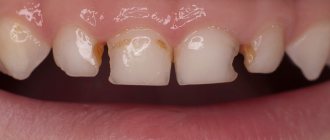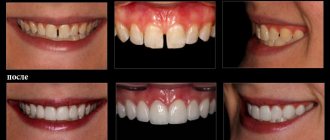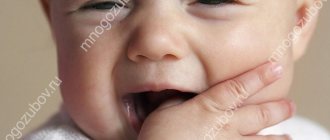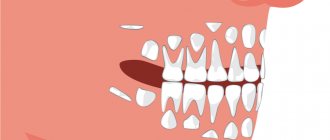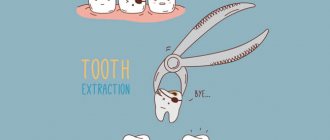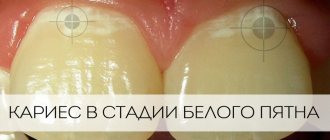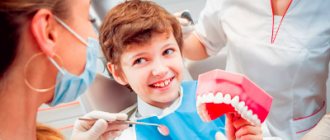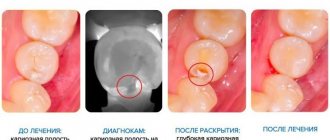Increasingly, parents with young children whose front teeth are badly damaged come to the pediatric dentist for appointments. As you know, caries in baby teeth, especially in young children, develops at lightning speed. While parents, having noticed initial changes in the enamel of their front teeth, decide to consult dentists (according to statistics, parents choose a local clinic for their first visit to a pediatric dentist), who recommend brushing your teeth regularly, or at most coat your teeth with fluoride varnish or silver plate them; precious time is lost.
Dentists in specialized pediatric dentistry already see teeth in the child’s mouth that are destroyed, often down to the gum level.
Naturally, parents want to give their baby back a beautiful and healthy smile; knowing full well that the front teeth are needed not only for beauty, but also for the correct formation of the bite and production of the correct sounds.
There are several treatment options for decayed teeth in children.
Option one.
The need for restoration
The replacement of baby teeth begins at the age of five. They serve children up to a maximum of fourteen years of age, then they fall out and are replaced by permanent ones. They are not designed to be used for a long time. This variety has some features due to which they collapse faster than permanent ones.
These include:
- the layer of enamel in dairy milk is thinner than in permanent;
- the pulp chamber is closer to the surface;
- The dentin layer is also thinner.
Due to these features, caries develops faster in children. If it is not treated, pulpitis begins at lightning speed, and the coronal part is significantly destroyed. This process can take place without pain; the child gets to the doctor late. Most often he deletes this unit. Modern dentistry now makes it possible to restore almost completely destroyed crowns. Neither parents nor dentists consider it necessary to restore, let alone prosthetize, baby teeth for two reasons. The procedure is quite expensive, and there is no great need for it, since it is believed that the permanent ones will soon grow.
However, this must be done for the following reasons:
- if several units are missing, the child’s bite will not form correctly;
- improper redistribution of the load when chewing, they can shift and cover the eruption sites;
- in the absence of incisors, the child develops complexes because he is teased by his peers;
- the sharp edge of the destroyed unit injures the mucous membranes of the child’s oral cavity;
- in the absence, chewing of food is impaired, this threatens the development of gastritis and other digestive disorders;
- The baby may develop sound pronunciation defects.
It is imperative to treat caries in a child, as it can become permanent and contribute to the development of gum disease. However, the most dangerous consequence of losing baby teeth is the formation of a malocclusion.
What is an appointment with a pediatric dentist like?
The first thing any competent doctor should do when treating teeth is to win over the child. It’s worse if the little patient is already afraid of doctors and needs to be reassured right away. In any case, the classic technique consists of several stages:
- Visual examination of the oral cavity - you need to identify whether there are any obvious signs of caries, stomatitis, gingivitis and other diseases.
- Palpation and probing - determine the reaction to solid objects, tapping or a trickle of water.
- If necessary, an x-ray or panoramic tomography of the jaw is prescribed - this helps to exclude complications and identify possible malocclusions.
- Dental treatment is prescribed. Most often at the same appointment, if serious preparation and preliminary diagnostics are not required.
Indications and contraindications
There are quite a few cases in which prosthetics of baby teeth is indicated.
Here are the main ones:
- destruction of more than 40% of the coronal part by caries;
- loss of milk long before the date of its replacement with a permanent one;
- chipping of enamel as a result of injury;
- fluorosis with destruction of enamel;
- underdevelopment of the enamel layer;
- violation of the aesthetics of the dentition (wide gaps, crowding).
There are no absolute contraindications to the procedure in children. There are only relative contraindications.
These include:
- allergic reactions to filling material;
- lack of necessary oral hygiene;
- the baby’s condition does not allow for long-term treatment and recovery;
- they require treatment before recovery;
- bruxism;
- restored units will interfere with the eruption of permanent ones.
Even if your child has contraindications, you can choose the optimal type of restoration.
Modern methods and materials for the treatment of children's teeth
Progressive dental clinics, including dentistry “On Smolenskaya”, use special materials and innovative methods of “friendly” treatment. These include:
- silvering;
- use of remineralizing pastes;
- deep fluoridation of enamel;
- fissure sealing;
- ozone therapy;
- preparation with ultrasound or laser;
- chemical-mechanical preparation;
- the use of calcium-containing pads for deep caries, etc.
For treatment, special materials are used, glass ionomer cements and composite materials, developed taking into account the anatomical and physiological characteristics of primary teeth. They are selected for each tooth separately, taking into account its location, lesion, maturity and expected effect of therapy.
Types of restoration in children
The main task of prosthetics in children is the formation of a correct bite and the eruption of permanent teeth in the right places and at a certain time.
The following methods are used in children:
- Filling is the restoration of integrity using composite materials if the degree of damage is small. The material is not durable, but it can last up to four years. This is enough until they are replaced by permanent ones. Vitreous cement is also used for this purpose. It has good adhesion to the fabric and saturates it with fluoride. It is most often used for the front baby teeth. Fillings made of colored polymers are used in children. This material is used for filling chewing units. The advantage is that no drilling is required for installation.
- Inlays are used for large amounts of damage to the masticatory units. They are made from plastic, composite and medical steel. Before installing them, the pulp is removed and it is ground. In case of severe damage, a metal pin is installed in the canal and a tab is attached to it.
- Veneers are used for aesthetic restoration of incisors only, to correct defects and chips. This design is a plate that is made of composite materials or ceramics. Before installing the veneer, the front baby tooth is ground down.
- Crowns - this type of prosthetics is often used in adults and rarely in children. They are made from medical steel or an alloy of chromium and nickel, sometimes ceramics or zircon dioxide are used. Structures are installed in cases of severe destruction. More often in children, a plastic type of crown, the so-called Strip-crown, is used for restoration. They are plastic caps with a special composite placed inside them. They are then strengthened and a lamp is used to harden the cement. Before installation, they are ground and depulped.
- Dentures are installed in extreme cases of complete loss. Usually removable types of prosthetics are used, as the baby’s jaw grows. Designs change as they grow. For prosthetics in preschoolers, the following are used: bridges, plastic removable butterfly dentures, and plate structures.
Removable prosthetics are not very convenient, since the structures must be removed at night and washed.
What is dental restoration
Restoration of baby teeth in children is carried out in the following cases:
- for damage caused by trauma;
- due to complicated caries.
Dental injuries in childhood are common. At the children's dental clinic "Natadent" we are ready to provide timely and qualified assistance. According to statistics, every third child suffers a tooth injury during sports games or vigorous activity.
By acting correctly, you can even save a knocked out tooth:
- Regardless of the severity of the injury, you should come for an examination to a pediatric dentist;
- take a photo to assess the nature of the damage;
- if displaced, the tooth must be strengthened by applying a splint or in another way at the discretion of the doctor;
- Deliver the child, along with the knocked out tooth, to the dentist’s office within 30 minutes.
Important! A knocked-out tooth cannot be picked up by the root, washed with water or treated with antiseptic solutions - this can make the process of its healing impossible and complicate restoration. It must be carefully taken by the crown and placed in saline solution, on the child’s cheek or in another biological environment.
If a piece of enamel breaks off from an injured tooth and dentin is exposed, then it cannot be left in this form. It is necessary to see a dentist and restore the damaged edge. Through a thin layer of dentin, pathogenic bacteria will enter the pulp and cause pulpitis. This can lead to tooth decay and costly treatment.
The Natadent clinic has all the possibilities for preserving teeth, restoring them and restoring them. We are sure that tooth injury is not a reason for losing it.
Features of restoration in children
Since milk teeth have significant differences from permanent teeth, there are some peculiarities.
Peculiarities of recovery in children include:
- recovery in preschoolers is temporary, it is necessary for two or three years;
- special requirements are imposed on materials (high hypoallergenicity and safety);
- structures should not interfere with jaw growth and teething;
- Before restoration, the baby tooth must be depulped.
If you take these features into account, restoration of the milk teeth will allow you to achieve the appearance of smooth and healthy permanent teeth and the formation of a correct bite.
Prevention measures
Dental and oral health at any age is hard work that requires special attention. It is very important to instill responsibility and certain skills from childhood:
- You should brush your teeth at least twice a day, and ideally after every major meal. Use rinsing agents or irrigator together with the brush and paste;
- It is necessary to devote at least 3 minutes to oral hygiene so that all areas are cleaned evenly and the paste is used correctly;
- the daily diet will need to be balanced as much as possible - reduce the amount of sweets in favor of fruits, vegetables and dairy products;
- A preventative dental examination should be performed every six months. If there are suspicions of chronic diseases - monthly.
How restoration is done
The method in pediatric practice is chosen by the dentist. Its choice is determined by clinical feasibility. He is guided by the degree of destruction of the crown. The wishes and financial capabilities of the parents are then taken into account by him.
In what cases is each method used:
- a filling is placed if only one wall is destroyed;
- if two walls are missing, then it is carried out with depulpation;
- if three are missing, a crown is installed;
- in the absence of all the walls of the coronal part, and the roots are healthy, restoration is carried out using a crown and a reinforced structure.
Modern dentistry makes it possible to restore even almost completely damaged teeth.
When do you need to restore baby teeth?
There are three main areas in the field of primary occlusion prosthetics:
- restoration, which is required if the aesthetics are compromised or a small part of the crown breaks off,
- restoration of the apex by installing a crown,
- complete restoration if the tooth was removed along with the root.
Restoration must be carried out. Firstly, for the sake of aesthetics - this is especially important if the child is at an age when the opinions of his peers greatly influence the child’s mood and psychological comfort. Secondly, to normalize nutrition and eliminate pathologies of the gastrointestinal tract. If even part of the teeth are missing, the child may chew food poorly, which will affect the digestive organs. And the third reason why prosthetics must be carried out is the protection of the entire jaw system.
If chewing is uneven (on one side), facial asymmetry may appear. If there are no teeth, the rest will begin to shift, so there will simply be no room left for the permanent ones. Another consequence is a violation of the position of the antagonists that are located on the opposite jaw. Due to the fact that they will not have support, they will move vertically, i.e. fall out of the hole.
Bottle caries
Bottle caries
is the conventional name for caries of primary teeth, which occurs on a child’s front teeth due to night feeding and lack of regular oral hygiene. Most often, bottle caries affects the incisors and canines of the upper jaw. Carious lesions are usually multiple and localized on the cervical surface of the tooth (circular caries).
During the initial stage of bottle caries, there is still no enamel defect, but there are areas of whitish demineralization on it. At this stage, you can carry out non-invasive treatment of caries using the ICON method or carry out a course of remotherapy. The most appropriate treatment method is determined by the pediatric dentist after examining the child’s oral cavity. It is also possible to combine these two methods of treating caries, depending on the depth of the carious process. If timely measures are not taken to treat the demineralized area of enamel, the integrity of the enamel is quickly compromised, and dentin and pulp are involved in the process. The risk of tooth crown fracture increases due to the progression of the circular carious process.
The cause of bottle caries is the child's consumption of sugary drinks or milk without subsequent oral hygiene by the parent. Carbohydrates contained in these drinks (for example, lactose in breast milk, fructose in baby juices, sucrose in sweetened tea) accumulate on the tongue and on the surface of the child’s teeth, decompose to form acids that penetrate into the tooth through enamel micropores and have a destructive effect first on the enamel and then on the dentin. To prevent the occurrence of bottle caries, it is necessary to wipe the child’s teeth with a gauze or cotton swab, fingertip, or special wipes with xylitol after each drink or milk, regardless of the time of day.
Since bottle caries occurs in children under three years of age, due to their small age, treating them in consciousness is difficult and is only possible with the child being held by the parent, which reduces the quality of treatment, and most importantly, disrupts the child’s psyche and causes fear of dental appointments for life. Treatment of one-year-old children is recommended under general anesthesia.
It should be remembered that bottle caries in most cases has a lightning-fast course and complications in the form of pulpitis and periodontitis are possible, therefore, after a preliminary visual examination and analysis of x-rays of the diseased tooth, the doctor will be able to make an accurate diagnosis and draw up a treatment plan.
Treatment of caries of primary teeth cannot be delayed, since the enamel of recently erupted primary teeth has not yet been fully formed, and the carious lesion quickly deepens, affecting dentin, and then the pulp - the neurovascular bundle located inside the tooth. Having detected caries of baby teeth in the form of whitish spots, it can be cured “without drilling” using the ICON drug complex. Pigmented carious defects and the formation of depressions on the surface of the tooth indicate irreversible changes that have occurred to the enamel and dentin. In this case, preparation of the affected area of the tooth is required, excision of tissues that are non-viable as a result of carious lesions and placement of a filling.
Children 2–3 years old are less assiduous in a chair than a preschool child, therefore, for extensive carious lesions (more than 4 teeth), treatment of young children under anesthesia is recommended. During treatment, the drug Sevoran is used, as the safest and least toxic in modern dental practice. From the age of four, caries treatment can be carried out under sedation using nitrous oxide (laughing gas).
If a child, both at 3 years old and at 4–5 years old, is adapted and ready to cooperate with the dentist, treatment is carried out without additional sedatives. In our clinic, treatment is carried out using local anesthesia. First, the injection site is numbed with a special gel, then the injection is performed. After the onset of anesthesia, a rubber dam is fixed to the tooth, preventing saliva from entering the doctor’s working field, which contributes to a more long-term result of treatment of caries of primary teeth. The dental dam also minimizes the risk of damage to the soft tissues of the child’s oral cavity with sharp and rotating dental instruments, as well as chemicals used to place a filling.
Treatment of caries in a five-year-old child
Starting at age 4, caries in primary teeth can be treated under sedation using nitrous oxide (sometimes nitrous oxide is called “laughing gas”). However, if a child, both at 3 years old and at 4–5 years old, is adapted and ready to cooperate with a pediatric dentist, treatment is carried out without additional sedatives.
In our clinic, sanitation of the child’s oral cavity is carried out using local anesthesia. First, the injection site is numbed with a special gel, then an anesthetic is injected. Then a rubber dam is fixed to the tooth - a latex insulating material that prevents saliva from entering the doctor’s working field, which contributes to a more long-term result of the treatment of caries in primary teeth. The rubber dam also minimizes the risk of damage to the soft tissues of the child’s oral cavity with sharp and rotating dental instruments and chemicals used to place a filling.
Caries of baby teeth is eliminated using the same methods as permanent ones: first, the pediatric dentist removes necrotic (dead) tooth tissue using dental burs to form a cavity, which will then be filled with filling material. This is followed by its medicinal treatment and the introduction of a light-curing composite material into the tooth cavity, as well as special reagents that promote its better attachment to dentin and enamel. After this, the prepared tooth surface is restored to give it optimal aesthetic and functional parameters, the filling is grinded and polished.
